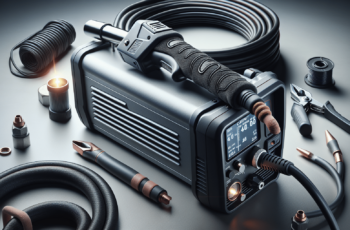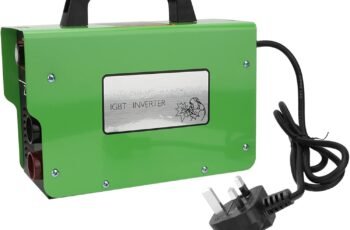Ad Blocker Detected
Our website is made possible by displaying online advertisements to our visitors. Please consider supporting us by disabling your ad blocker.
When you’re diving into the world of MIG welding machines for aluminum and stainless steel, there’s a lot to consider. You’ll need to understand the importance of multi-process functionality and how it affects your welding outcomes. Choosing the right machine with the capability to switch between gas and gasless modes can make all the difference. Curious about the specific wires, settings, and features that will give you the best results? Let’s explore what truly matters in your welding journey.
Power Requirements and Machine Specifications
When choosing a MIG welding machine for aluminum and stainless steel, understanding the power requirements and machine specifications is crucial. Look for models with dual 110V/220V voltage options for flexibility in different environments. You’ll need up to 30A input current for high-amperage tasks. The MIG-250PRO-DG 220V MIG Welder features a multi-function design that supports various welding modes, making it a versatile choice for different welding projects. For varied material thicknesses, an adjustable amperage range from 40A to 250A is essential. A 60% duty cycle at 160A means you can weld continuously for 6 minutes out of every 10. Additionally, specialized technologies like VRD, Hot Start, and Arc Force improve safety and arc stability. For stainless steel, aim for up to 210A, while aluminum requires lower settings to avoid over-penetration. Ensure compatibility with wire sizes and consider spool gun integration for aluminum.
Multi-Process Functionality and Modes
After understanding the power requirements and machine specifications, let’s explore the versatility that multi-process functionality brings to MIG welding machines.
You can weld using MIG, FLUX, Lift TIG, Stick, and Spool Gun MIG all in one unit. These machines offer gas/gasless MIG hybrid capability, allowing you to switch easily between inert gas-shielded and flux-cored welding.
Lift TIG mode gives you precise control without needing a separate TIG machine. Spool gun compatibility simplifies aluminum welding by reducing wire feed issues. The MIG-205DS-Pro Multi-Process MIG Aluminum Welder includes a 10ft MIG gun with a graphene liner, ensuring optimal performance and durability during welding tasks.
With synergic mode settings, auto voltage matching, and material-specific presets, you can quickly configure for different metals. Plus, DCEP polarity and transfer modes optimize arc stability, while real-time monitoring and spool gun integration streamline aluminum projects.
Material Compatibility and Thickness Guidelines
If you’re working with different metals, understanding material compatibility and thickness guidelines is crucial for successful MIG welding.
For stainless steel, choose ER308, ER308L, or ER308LSI wires to maintain corrosion resistance. Aluminum requires ER4043 wire for consistent fusion, while carbon steel benefits from ER70S-6. MIG welding is versatile for a range of thicknesses, making it suitable for both thin and medium-thick metals.
Wire diameter is important; use .023″ for ≤18 gauge, .030″ for 18–3⁄16″, and .035″ for >3⁄16″.
When welding aluminum, stick to a minimum of 14 gauge (.074″), with a practical lower limit around 1⁄8″. For thicker sections, ensure your machine has high output and use spray transfer.
For steel, adjust wire and amperage according to thickness: .023″ for thin sheets, .030″ for medium, and .035″ for structural integrity.
Advanced Features for Enhanced Precision
Although technology constantly evolves, the need for precision in MIG welding remains paramount.
You’ll find advanced features in modern machines that enhance accuracy and control. Auto Set™ technology determines the best voltage and wire feed speed, eliminating guesswork. Pulsed MIG functionality offers a stable arc, reducing spatter and improving weld quality on thin materials. For custom applications, adjust voltage by ±3V, while Locks and Limits protocols maintain consistent quality by restricting unauthorized changes. The 7-inch color LCD display allows for intuitive machine operation, providing real-time parameter monitoring, ensuring you’re always informed.
Program Mode simplifies setup with predefined settings, ideal if your experience varies. A 7-inch color LCD provides real-time parameter monitoring, ensuring you’re always informed.
Synergic MIG mode automates setup by matching wire feed speed and voltage. These innovations collectively ensure optimal precision in your welding projects.
Gas Shielding and Environmental Factors
With precision enhancements in modern MIG welding machines, gas shielding and environmental factors become key to achieving high-quality welds. For stainless steel, tri-mix gases boost arc stability and weld characteristics, while argon-rich blends are cost-effective and minimize spatter. Aluminum requires pure argon to prevent porosity and oxidation. Clean workspaces are crucial to avoid contamination, especially with stainless steel, which is prone to distortion due to slow heat conduction. Humidity and contaminants can weaken welds, so ensure strict shielding. Proper gas flow rates prevent under-shielding or over-shielding. Argon provides better arc stability, which is essential for maintaining a clean weld and influencing characteristics such as spatter levels. Equipment like the Millermatic 211 offers compatibility with specific gases, enhancing welding precision. Always maintain torch nozzle cleanliness and optimize gas flow to ensure consistent arcs and high-quality welds.
Performance Optimization Tips for Effective Welding
When it comes to optimizing welding performance, understanding and controlling heat input is crucial. Adjust the voltage and wire feed speed to balance heat, minimizing burn-through. Fast travel speeds help limit heat buildup and potential distortion.
Rearrange your weld sequence to focus on low heat-sink areas first, and make short, sequential welds to distribute heat evenly. Pulsed MIG welding offers precise current modulation, reducing thermal impact.
For machine settings, set amperage proportionally to the material’s thickness and optimize parameters through testing. Consistent stickout length ensures a stable arc, while correct polarity is essential for the process.
Choose the right electrode by matching wire diameter to material thickness and prioritize low-spatter options. Employ stringer beads for productivity, using copper backing bars to dissipate heat effectively.
Recommended Practices for Aluminum Welding
To achieve optimal results in aluminum welding, it’s crucial to master specific techniques and equipment tailored to this material’s unique properties.
Start by using the push MIG technique to direct shielding gas effectively, reducing porosity. Argon gas is essential for inert protection. For thin sections, opt for pulsed MIG or AC current to prevent overheating.
Always remove oxides with grinding or chemical cleaning before welding. Choose TIG or pulsed MIG tools for better arc control, and use pure tungsten electrodes or aluminum-specific MIG wire for optimal welds.
Manage heat input carefully—preheat slightly, maintain fast travel speeds, and monitor interpass temperatures. Clean and degrease materials before welding, and use backing materials to prevent burn-through in thin sections.
Considerations for Stainless Steel Welding
Although stainless steel welding presents unique challenges, understanding the nuances can significantly enhance your results.
Choose MIG welding for materials 3/16-inch or thicker, while TIG is best for precise, thin sections. Avoid stick welding due to arc stability issues. Match filler metals to base metal composition to prevent corrosion, and use appropriate wire diameters for optimal penetration.
Argon-based gases, with purity levels of 99.9%, prevent oxidation, while flow rates should be adjusted based on weld size and design. Equip yourself with the right accessories: gun liners, wire feeders, and consumables like contact tips.
Ensure your welder’s duty cycle matches project demands. For critical applications, adhere to standards like ASME Section IX, and validate integrity with post-weld testing.
Conclusion
When choosing a MIG welding machine for aluminum and stainless steel, focus on multi-process functionality, like switching between gas and gasless modes. Use ER308 wires for stainless steel and ER4043 for aluminum to ensure quality. Consider features like auto-set technology and pulsed MIG functionality for precision. Don’t forget to adjust gas flow rates for stable arcs. By selecting the right equipment and settings, you’ll achieve optimal welding performance and high-quality results.



